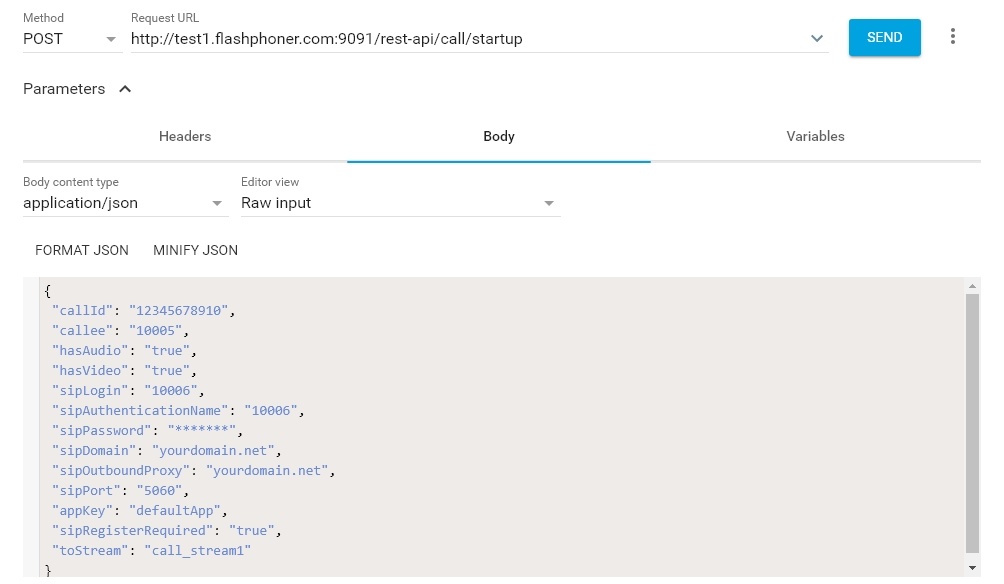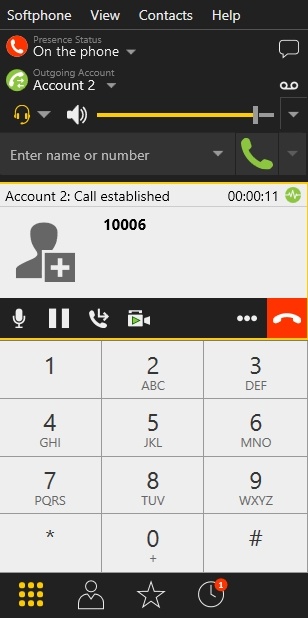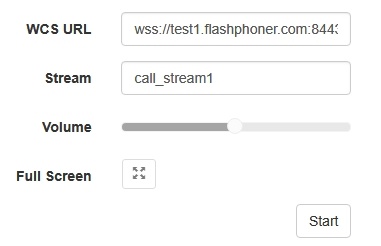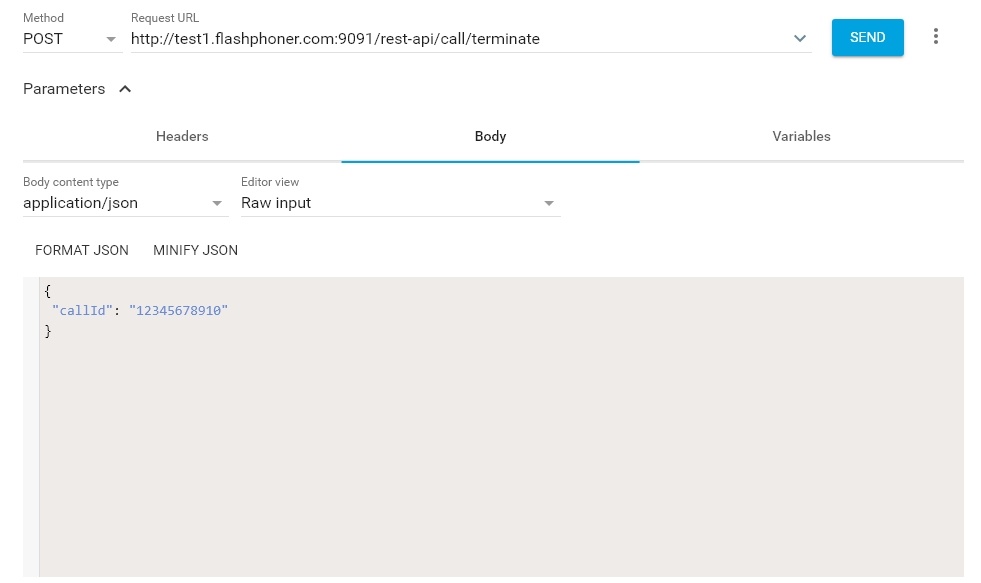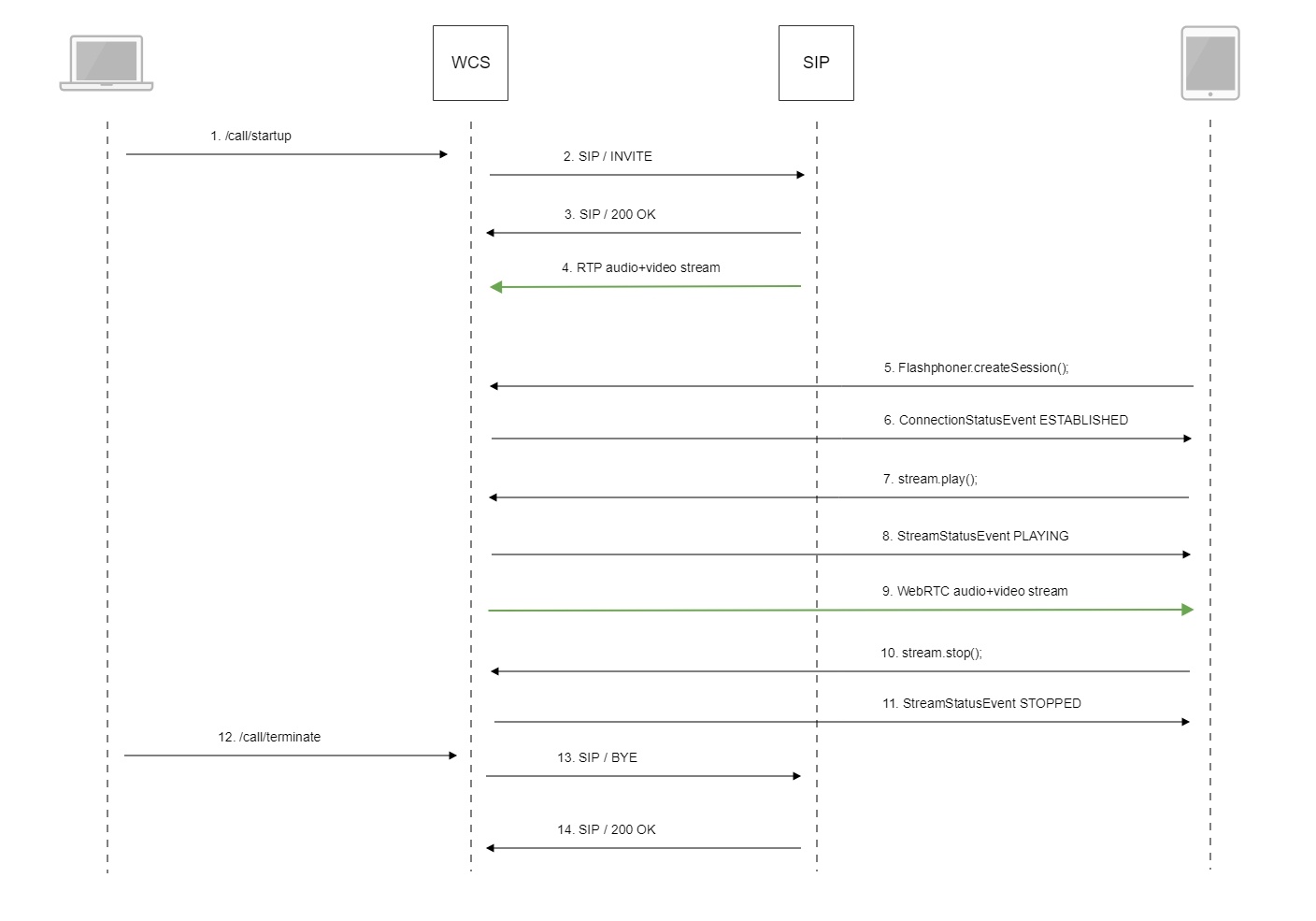Overview
A SIP call made through the WCS server can be captured into a stream on the server when the call is created. Then this call can be played in a browser using any method supported by WCS.
The stream captured from a SIP call can be republished to an RTMP server using the REST query /push/startup, just like any media stream on the WCS server.
Operation flowchart
- The browser starts a call using the /call/startup REST query
- WCS connects to the SIP server
- The SIP server sends the RTP stream of the call to WCS
- The second browser requests playback of the call stream
- The second browser receives the WebRTC stream
Quick manual on testing
1. For this test we use:
- two SIP accounts;
- the softphone to answer the call;
- the REST-client in the Chrome browser;
- the Player web application to play the stream.
2. Open the REST client. Send the /call/startup query to the WCS server and specify the following as query parameters:
- parameters of your SIP account the call will be made from;
- the stream name to republish the call to (the toStream parameter), for example, call_stream1$
- the name of your second SIP account the call will be made to.
3. Receive and answer the incoming call on the softphone:
4. Open the Player web application and in the "Stream" field specify the name of the stream the call is redirected to (in our example: call_stream1):
5. Click "Play". The stream starts playing:
6. To terminate the call, send /call/terminate from the REST client to the WCS server and pass the call id in the parameters:
Call Flow
Below is the call flow when using the SIP as RTMP example to create the call and the Player example to play it
1. Sending the REST query /call/startup:
sendREST() code
function startCall() {
...
var url = field("restUrl") + "/call/startup";
callId = generateCallID();
...
var RESTCall = {};
RESTCall.toStream = field("rtmpStream");
RESTCall.hasAudio = field("hasAudio");
RESTCall.hasVideo = field("hasVideo");
RESTCall.callId = callId;
RESTCall.sipLogin = field("sipLogin");
RESTCall.sipAuthenticationName = field("sipAuthenticationName");
RESTCall.sipPassword = field("sipPassword");
RESTCall.sipPort = field("sipPort");
RESTCall.sipDomain = field("sipDomain");
RESTCall.sipOutboundProxy = field("sipOutboundProxy");
RESTCall.appKey = field("appKey");
RESTCall.sipRegisterRequired = field("sipRegisterRequired");
for (var key in RESTCall) {
setCookie(key, RESTCall[key]);
}
RESTCall.callee = field("callee");
var data = JSON.stringify(RESTCall);
sendREST(url, data);
startCheckCallStatus();
}
2. Establishing a connection to the SIP server
3. Receiving a confirmation from the SIP server
4. The RTP stream of the call is sent to the WCS server
5. The Browsers establishes connection to the server.
Flashphoner.createSession(); code
Flashphoner.createSession({urlServer: url}).on(SESSION_STATUS.ESTABLISHED, function(session){
setStatus(session.status());
//session connected, start playback
playStream(session);
}).on(SESSION_STATUS.DISCONNECTED, function(){
setStatus(SESSION_STATUS.DISCONNECTED);
onStopped();
}).on(SESSION_STATUS.FAILED, function(){
setStatus(SESSION_STATUS.FAILED);
onStopped();
});
6. Receiving from the server an event confirming successful connection.
ConnectionStatusEvent ESTABLISHED code
Flashphoner.createSession({urlServer: url}).on(SESSION_STATUS.ESTABLISHED, function(session){
setStatus(session.status());
//session connected, start playback
playStream(session);
}).on(SESSION_STATUS.DISCONNECTED, function(){
...
}).on(SESSION_STATUS.FAILED, function(){
...
});
7. Request to play the stream.
stream.play(); code
stream = session.createStream(options).on(STREAM_STATUS.PENDING, function(stream) {
var video = document.getElementById(stream.id());
if (!video.hasListeners) {
video.hasListeners = true;
video.addEventListener('playing', function () {
$("#preloader").hide();
});
video.addEventListener('resize', function (event) {
var streamResolution = stream.videoResolution();
if (Object.keys(streamResolution).length === 0) {
resizeVideo(event.target);
} else {
// Change aspect ratio to prevent video stretching
var ratio = streamResolution.width / streamResolution.height;
var newHeight = Math.floor(options.playWidth / ratio);
resizeVideo(event.target, options.playWidth, newHeight);
}
});
}
...
});
stream.play();
8. Receiving from the server an event confirming successful playing of the stream.
StreamStatusEvent, status PLAYING code
stream = session.createStream(options).on(STREAM_STATUS.PENDING, function(stream) {
...
}).on(STREAM_STATUS.PLAYING, function(stream) {
$("#preloader").show();
setStatus(stream.status());
onStarted(stream);
...
});
stream.play();
9. Sending audio- and video stream via WebRTC
10. Stopping playing the stream.
stream.stop(); code
function onStarted(stream) {
$("#playBtn").text("Stop").off('click').click(function(){
$(this).prop('disabled', true);
stream.stop();
}).prop('disabled', false);
...
}
11. Receiving from the server an event confirming unpublishing of the stream.
StreamStatusEvent, status STOPPED code
stream = session.createStream(options).on(STREAM_STATUS.PENDING, function(stream) {
...
}).on(STREAM_STATUS.PLAYING, function(stream) {
...
}).on(STREAM_STATUS.STOPPED, function() {
setStatus(STREAM_STATUS.STOPPED);
onStopped();
}).on(STREAM_STATUS.FAILED, function(stream) {
...
}).on(STREAM_STATUS.NOT_ENOUGH_BANDWIDTH, function(stream){
...
});
stream.play();
12. Sending the /call/terminate REST query:
sendREST() code
function hangup() {
var url = field("restUrl") + "/call/terminate";
var currentCallId = { callId: callId };
var data = JSON.stringify(currentCallId);
sendREST(url, data);
}
13. Sending the command to the SIP server
14. Receiving confirmation from the SIP server

